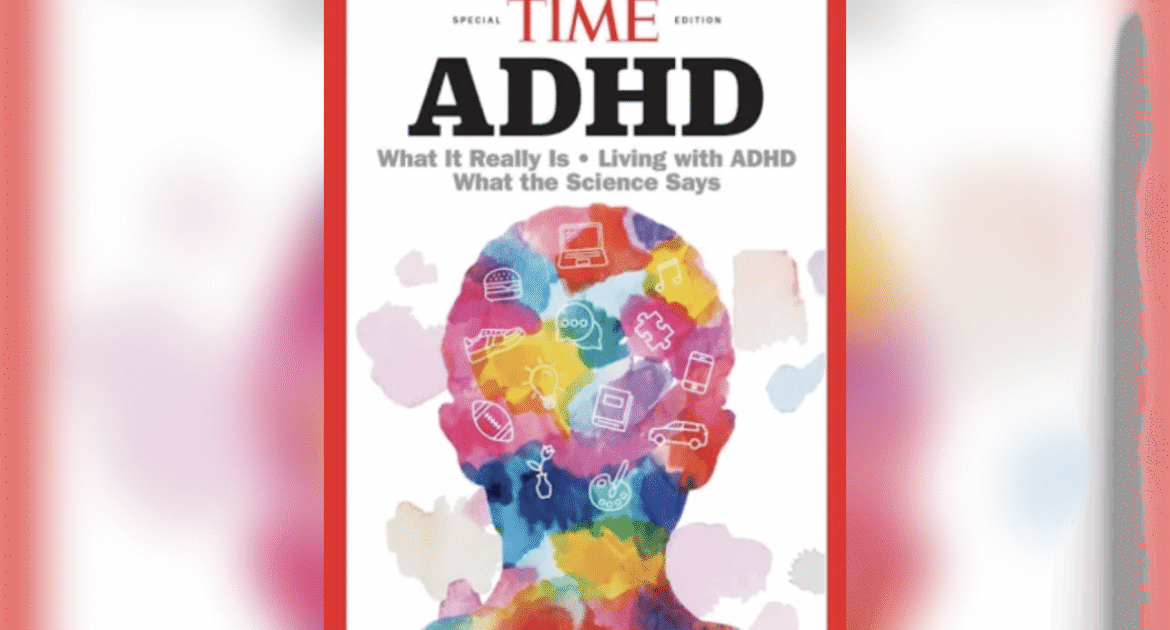
ABLECHILD: TIME Magazine Publishes Reckless ADHD Spin In Glitzy Special Edition


TIME Magazine Reckless ADHD Spin In Glitzy Special Edition
Republished with permission from AbleChild
Time Magazine has out on the grocery store shelves a 96-page “Special Edition” titled “ADHD What It Really Is – Living with ADHD – What the Science Says.” It’s glitzy, colorful and bold, but it does not answer what ADHD is and, frankly, rolls out the same tired, unsupported, and just plain wrong nonsense about normal behavior made abnormal by psychiatry.
The article explains that “the first thing to understand about ADHD is that it is a neurodevelopmental disorder,” and that means “it begins during childhood, even if it isn’t diagnosed until you’re an adult, or even if you don’t become aware of the symptoms until later in life.” Uuh ok. But don’t all human behaviors begin in childhood? Aren’t all childhood behaviors neurodevelopmental?
But it’s the following statement that just blows the understanding of ADHD to smithereens “The exact cause of ADHD is unknown, but so far research suggests it’s largely genetic.” Really? The deep thinkers at Time did not provide a source for that outlandish “scientific” statement. Science doesn’t know what causes the alleged ADHD but “research suggests?” That’s it? That makes a “Special Edition?”
It gets worse. Next Time explains that “the hope is that future research will help illuminate the precise cause of ADHD.” And “people with ADHD experience differences in the frontal lobes of their brains.” Really? Again, this sounds impressive, really science like, but Time does not provide a source for that frontal lobe information. In fact, anyone familiar with the history of the ADHD fraud would know that, over the years, many brain scan projects have suggested that those with ADHD have differences in their brains compared to those who have not been diagnosed with ADHD.
The problem arises when you confront the scientists that conduct these brain scan research projects, when they admit that they did NOT consider, nor even ask, whether the participants had taken prescription mind-altering drugs prior to the scan or for what length of time the participants have been on drugs. Without that information, the difference in brain scans could be due to use of the ADHD drug “treatments.” Of course, there is a reason that these important questions are not asked. The next follow up question to that scientist would have to be is who is funding that brain scan research.
Moving along, Time discusses the on-going debate about the drugging of children and now, an ever-increasing number of adults, with Schedule II drugs like Adderall, Ritalin and Vyvanse. Schedule II drugs have a high potential for abuse and severe psychological or physical dependence. And what other drugs are Schedule II? Fentanyl, hydrocodone oxycodone, morphine, codeine, and cocaine. In fact, Adderall and Ritalin are methamphetamine and methylphenidate and the closest thing we have to cocaine.
Time explains that “leading ADHD researchers insist there are few negative side effects from long-term stimulant prescriptions…” Cocaine is a stimulant. Would any scientist provide the same conclusions about using cocaine every day? But these ADHD “treatments” are the closest thing we have to cocaine. Certainly, it doesn’t sound good for a five-year-old.
To make the point that ADHD is a made-up disorder, Time explains “because there is no biomarker for the condition that can be found through a test the way that, for example, cancer or high cholesterol can be…this creates an opportunity for skeptics to raise questions.” Yep. Sure does. No biomarker means no objective, confirmable abnormality. Without an abnormality, what exactly is being “treated?”
And, how about those ADHD “treatments?” What do the pharmaceutical companies say about how their drugs work as “treatment?” “The mode of therapeutic action in attention deficit hyperactivity disorder (ADHD) is not known.” Haven’t got a clue. Zero, zilch, big hole in donut! The pharmaceutical companies don’t know how the drug “treatments” work as “treatment” for ADHD. Feeling pumped up now. Why doesn’t the Special Edition provide that information?
It’s around page 60 of the Special Edition that helpful information, not guess work about what ADHD isn’t, is provided for those who are having difficulty concentrating and providing helpful hints to better sleep, diets, and even exercise routines. The fact is, a Special Edition wasn’t needed, and the entire ADHD discussion could have been a simple article.
In a nutshell, science has no clue what the alleged disorder ADHD is and after 100 years of study of behaviors, science still cannot pinpoint why kids and even adults wiggle in their chairs, lack focus, speak out of turn and lose or forget things. Maybe, just maybe, it is normal for those people.
Further, to even suggest that there are no long-term adverse events associated with the numerous ADHD drug “treatments” could not be further from the truth. Beyond the known dependence to many of the drugs, there recently was a JAMA Psychiatry study “Occurrence of Psychosis and Bipolar Disorder in Individuals with Attention Deficit/Hyperactivity Disorder Treated with Stimulants” that reveals “an increased risk of psychosis and bipolar disorder in patients with ADHD treated with stimulants.” But, of course, this makes sense if someone is taking the equivalent of cocaine every day for years.
Finally, pathetically, Time wraps up the Special Edition with the rich and famous who have been diagnosed with the alleged ADHD. Why? Why is it necessary to use famous athletes, actors, comedians and musicians to push the alleged disorder?
One could legitimately argue that there are millions who have experienced negative effects from being diagnosed and drugged from a very young age. These stories are just as important, especially because there is no science to support any known abnormality that is the alleged ADHD. Providing both sides of the story is what makes good journalism. Without all the information, there is no informed consent and the attempt at journalism simply becomes propaganda. Meh, after careful review, this “Special Edition” really isn’t so special.
Be the Voice for the Voiceless
AbleChild is a 501(3) C nonprofit organization that has recently co-written landmark legislation in Tennessee, setting a national precedent for transparency and accountability in the intersection of mental health, pharmaceutical practices, and public safety.
What you can do. Sign the Petition calling for federal hearings!
Donate! Every dollar you give is a powerful statement, a resounding declaration that the struggles of these families will no longer be ignored. Your generosity today will echo through generations, ensuring that the rights and well-being of children are fiercely guarded. Don’t let another family navigate this journey alone. Donate now and join us in creating a world where every child’s mind is nurtured, respected, and given the opportunity to thrive. As a 501(c)3 organization, your donation to AbleChild is not only an investment in the well-being of vulnerable children but also a tax-deductible contribution to a cause that transcends individual lives.
The post ABLECHILD: TIME Magazine Publishes Reckless ADHD Spin In Glitzy Special Edition appeared first on The Gateway Pundit.
